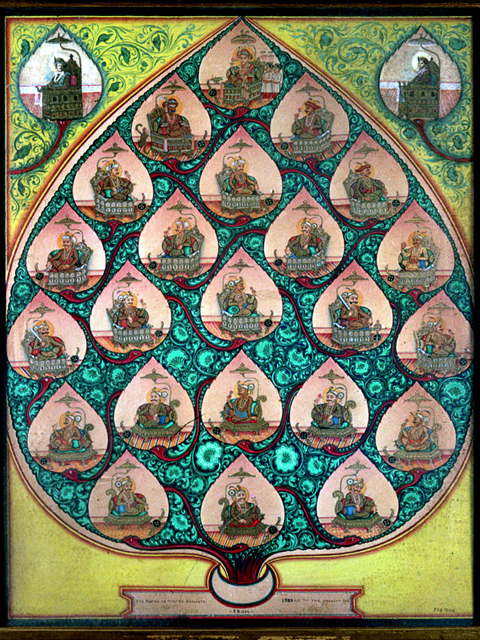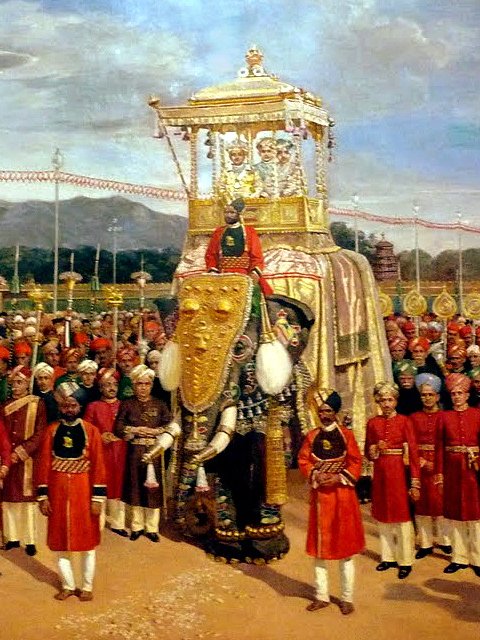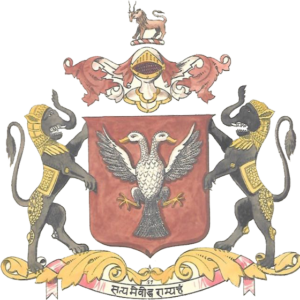
The Wadiyars have been the Custodians of the rich traditions and culture of the Deccan, inherited from their predecessors, the Kadambas, the Rashtrakutas, the Gangas, the Chalukyas, the Hoysalas, and lastly the Vijayanagara Empire. The Wadiyar Dynasty, over its 600 year reign has been witness to the rise and fall of India’s greatest empires, has overcome the tyranny of usurpation, and withstood many a change in political landscape. Despite these upheavals the Dynasty produced the greatest times of prosperity the Deccan has seen. Throughout these 600 years the Wadiyars of Mysore have strived to preserve, nurture, and further cultivate the rich culture of the Deccan that was passed on to them via their predecessors. The narrative of the Deccan and that of the Wadiyars of Mysore are interwoven and the richness of the Deccan culture finds efflorescence in their age-old tradition.
The Wadiyar Dynasty was founded in 1399 C.E., by Yaduraya. They remained vassals and and later Viceroys to the Vijayanagara Empire, that had dominion over most of Peninsular India. With the decline of the Vijayanagara Empire, the Wadiyars under Raja Wadiyar I wrested control of Srirangapatna, and then further proceeded to expand under his successors, reaching great heights of prosperity under rulers such as Kanteerva Narasihmaraja Wadiyar I, and Chikka-Devaraja Wadiyar in the 1600’s.
In the years following, during the 1700’s, Hyder Ali, the Commander-in-Chief or Delavoy of Mysore usurped power from the Wadiyars, later his son Tipu Sultan, would declare himself ruler of the state and look to completely overthrow the Wadiyars. He was however thwarted, in no small part due to the efforts of Maharani Lakshmammani Avaru, wife of Krishnaraja Wadiyar II, and defeated in the Fourth Anglo-Mysore War.
Maharani Lakshmammani Avaru would successfully see the Kingdom return to her Grandson Mummadi Krishnaraja Wadiyar (Krishanaraj Wadiyar III), thereby ushering in the Princely Era of Mysore, which would take Mysore to newer heights of Prosperity during the Golden Age of Mysore with visionary leaders such as H.H. Chamaraja Wadiyar X, H.H. Nalvadi Krishnaraja Wadiyar, and H.H. Dr. Jayachamarajendra Wadiyar Bahadur.
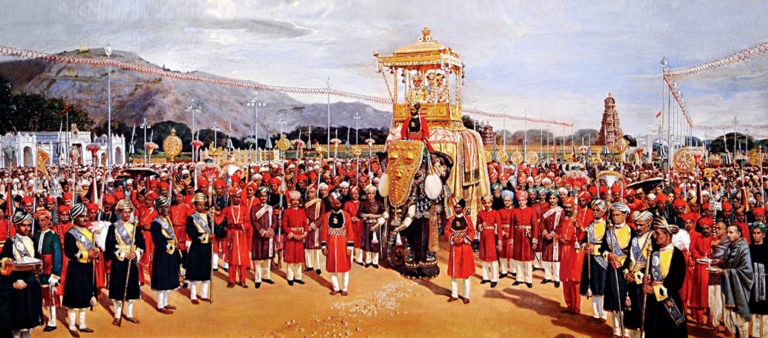
ETYMOLOGY
The Dasara, or more correctly ‘Dasahara’, is derived from the the Sanskrit ‘Dasa’, i.e. ten, and ‘ahan’, i.e. a sacrificial or festival day. It refers to the tenth day of the bright fortnight of the Asvina Masa. (Asvayuja Suddha) The first nine days of the same month refer to the Navarathri, or Nine Nights Festival dedicated to the Goddess Durga, the tenth being Dasara, is the concluding festival in honour of the same Goddess, celebrating her victory over evil. The Navarathri, more specifically the Sharan-Navarathri; ‘Sharan’ referring to the Autumn season, is very closely connected the Dasara, being in fact the tenth and last day following it, and hence the Nine Nights Festival, the Navarathri, as well as the tenth day Festival, Dasara, have been collectively styled, over time, as Dasara, and perceived as one continuous festival of ten days.
ORIGIN
The true origin of the festival is lost to time. We can however largely relegate to matter of origin to two sources, in our mythological history, and in our recorded history.


MYTHOLOGICAL SOURCES
Of the origin are mainly from the Vishnu Purana, Venkatesa Mahatmya, the Ramayana, and perhaps of most importance to Mysore, the Kalika Purana. The Vishnu purana regards the Dasara day as commemorating the victory of the Devatas over the Daityas during the Churning of the Great Ocean. The Ramayana regards the day as commemorating Lord Rama’s victory over the demon Ravanna, and according to the Kalika Purana, the day marks the celebration of the defeat of the demon Mahishasura, by the Goddess Durga.
HISTORY : THE FESTIVAL DURING THE VIJAYANAGARA PERIOD
During the Vijayanagar period of South Indian history, which was essentially Hindu in character, it attained to great celebrity. As will be seen from what follows, the festival attracted wide attention during the 15th and succeeding centuries from European travelers, who, as now, were evidently much impressed with it. If one wants to get some idea of its old-world splendor, one must read their accounts and witness the festival as it is celebrated to-day in Mysore to realize how tradition is kept up in India. The Vijayanagar kings were warriors and conquerors in their days and they carried on the Hindu tradition of the Epic days to its fullest extent. It would seem that Mysore, which was connected for a long time with them, has inherited the tradition almost without a break. It is remarkable, in the first instance, that the festival should have been conducted in the same manner during the past so many centuries; so much at least we may infer from the fact that the description left to us a hundred year ago by a European officer might do service as a true picture of it at the present day. Enquiries show that there is no formal written record of what is to be done every year in connection with it.
This indicates the stability of oral tradition in India. The-details have been and are transmitted from generation to generation with that unfailing fidelity which is one of the marked characteristics of orthodox India. This, however, is only one aspect of this interesting festival. Leaving aside tradition, which Connects it with the Pandava brothers, there is the solid fact. that we have an interesting, though brief, description of it in the writings of that well-known old Italian traveler Nicolo Dei Conti who, if not the first to visit. the capital of the ancient Vijayanagar Kingdom, was at least the earliest we know of who has left a description of it to us. He travelled in Southern India about the year 1420 A.D., when the ruling king of that dynasty was Deva Raya. This was possibly the second of that name who ruled over far-famed Vijayanagar and he was not only a fighting monarch, but apparently one who indulged in external show and pomp. Despite-troubles on the frontier, he was well able to keep a splendid court, whirls shows how early ease and love of pleasure were sapping the foundations of the new Hindu Kingdom of the South. He was possibly the first to turn the old Pandava festival to account, a stroke of policy that must have endeared him to his-subjects and made him literally the upholder of ancient kingship. He was, so far as we now know, the first of his dynasty to be dignified with the Imperial title, and his new pomp may have had some connection with this. However that may have been, Nicole Dei Conti describes the festival, “which lasts for nine days,” and in his account makes it sufficiently clear that hook-swinging was quite an item of the daily programme. Happily it has now long been absent from Mysore Dasara annals. That the Italian did not invent the festival in his fertile brain is made clear by the account of the Persian ambassador, Abdur Razzak, who spent over seven months at the old Hindu capital between May and December 1443. He called it by its well-known alternative name of ” Maha Navami ” (or the Great Navami) and what is interesting is the importance he attaches to the throne, which, curiously enough, is the object in Mysore of the greatest veneration during the nine days of the festival. It is then that the Maharaja takes his seat upon it and in the whole year this is the only time that it can ordinarily be seen. The throne which Abdur Razzak saw ” was of extraordinary size, was made of gold, and enriched with precious stones of extreme value,” a description that may verbatim et literatim be applied to the pre-sent Mysore Maharaja’s throne, to get a glimpse of which thousands on thousands of all classes crowd on the tenth day of the festival. The details of the festival, too, were remarkably like those that we see today at Mysore. Girls were there in dazzling attire, dancing “behind a pretty curtain opposite the king”. There were countless performances given by jugglers, who displayed elephants marvelously trained. Fireworks, games and amusements of diverse sorts went on mm day to day, until on the last day the visitors were presented to the king. A more elaborate description of the festival appears in the Portuguese Chronicle of Nuniz, who visited the Vijayanagara capital during the height of its glory, about 1536 A.D. in the reign of Krishna Raya (1508-1530). It is interesting to note the origin he ascribes to the festival. “Some say,” he writes, “that they do this in honor of the nine months during which our lady bore her son in the womb; others say it is only done because at this time the captains (local chiefs) come to pay their rents to the king.” The former is possibly a Portuguese, missionary fabrication and the latter indicates doubt-less the political turn the festival was given during the height of Vijayanagar glory. His account further shows that the kings took the opportunity of this feast to bestow honors and presents. Even more elaborate and picturesque in the extreme is the description of the great festival given by Pies, another Portuguese traveler, who wrote about 1520, evidently from personal impressions derived on the spot. It extends to over sixteen pages of Mr. Sewell’s excellent work on the Vijayanagar Empire, and those who wish to get some idea of the splendor of this old-world feast ought to read it. One remark, however, might be made here and that is the partiality shown to the number nine in the details of the ceremony. The festival was of nine days’ duration, and several things relating to it were somehow connected with that number. Nine castles were raised before King’s palace for the occasion; and nine goats, nine buffaloes and nine sheep were sacrificed during its progress an item which advancing civilization happily has found it possible to dispense with in Mysore. In addition to gorgeous display the grand review of troops in which the old Hindu kings indulged at the close of the festival has survived to our own days, and the many shows that one sees to-day at Mysore strongly remind one of the picturesque details of old chroniclers, and of the scenes depicted with vigour and finish on medieval temple walls and the basements of pillared halls all over Southern India, which for three centuries and more was under Vijayanagar sway. One of the most extraordinary of these is to be found amongst the ruins of Hampi itself, which little feverish village marks the site of old Vijayanagar. This is the great ruined square platform, which is such a striking object of wonder and admiration, just to the north of the place known as the “Queen’s Bath”. It is apparently the place called the House of Victory by Peso and is described at length by Mr. Francis, in his District Gazetteer of Bellary. “The people know it now,” he writes, ” as the Dasara Dibba or Maha Navami Dibba (meaning the platform Dibba), used at the nine days’ feast called variously the Dasara, the Maha-navami or the Navaratri ‘nine nights’. Pies says it was called the House of Victory because it was built when Krishna Deva Raya came back from his victorious expedition against the King of Orissa (A.D.1513) and his description of the festivities of Dasara, of which this building was throughout the centre, is one of the most vivid parts of his chronicle. There was obviously originally another erection on the top of the square platform or terrace which is all that now remains. The series of carvings which run round this latter are (with the exception, perhaps, of some of the similar examples in the Hazara Ramaswami temple) the most spirited in all the ruins. Elephants, camels and horses alternate with wrestlers and boxers, scenes representing black-buck shooting and panther spearing and girls dancing…. As far as is known these mural sculptures are unique in Southern India, and they have been compared by Fergusson with some of Layard’s discovery in ancient Nineveh. On the ground close under the northern wall of the terrace lies a curious door cut (bolt-sockets and all) from one .stone, and paneled to represent wood. On the western side the building has been rather clumsily faced at a later date with a series of carvings in a fine grained green stone. This material admitted of much more delicate work than the granite, and the result is several excellent panels, notably one showing a tiger hunt and another an elephant which is turning and rending its mahouts. This green stone is not native to the city and must have been quarried elsewhere.” Sue’s is the festival, a festival grown grey with age and historical associations. What is stated above should explain, to some extent at least, the popular attraction that the festival exerts to this day. Popular imagination delights in asserting—and there appears in this something more than a particle of historical truth-that the present ruler of Mysore is the sole repository of the traditions of the great Vijayanagar dynasty, and that the old Vijayanagara throne (Spoken of in such glowing terms by the Italian traveler conti) continues in possession of the present Mysore family. Herein the historically inclined, no less than those merely enjoying a picturesque show that spreads itself joyously over nine days, will see the causes of the popularity of the Dasara festival at Mysore. It is festival of joy, peace and loving loyalty shown by the masses to their Sovereign Lord and King.
THE DASARA IN SRIRANGAPATTANA
With the transfer of power from Vijayanagara into the hands of Raja Wodeyar, the traditions of the fallen empire were also transferred to Mysore. Raja Wodeyar resumed the Dasara festivities in his capital of Srirangapatnam, true to its original scale in Hampi. The festival begun with the King having finished the ritual oilbath, would proceed to the shrine of Chamundeshwari in the Palace, where the sacred Kankanadhara would be undertaken. The King would then proceed to the Sejje for the Navagraha Puja and Simhasana puja, much like today, after which he would ascend the fabled throne, amidst resounding bells, bugles and titles. Priests from various temples and representatives of prominent Mathas would present the King with consecrated water and rice. Infantry, cavalry, courtesans, elephants, horses and camels would then pay their homages from the ‘Kemmannu matti’ in front of the Palace.
The state elephant and horse would then be led in a procession to a marked place on the banks of the Cauvery, where ritual oilbath and other respects were paid to them under a special canopy by a designated member of the royal family. Magnificently adorned state elephant and horse, after receiving homages of various sorts would then proceed to the kemmannu matti to offer homage to the King. The King would then be presented with various rituailistic honors. After royal women paid their respects, the King would depart from the Sejje to finish rituals for worship. The evening Durbar saw noblemen and prominent citizens paying their homages to the King, and similar to the Dasara in Vijayanagara, there would be colorful shows of dance, games and firework. Popular sports included wrestling, bull fight and billy goat fight, of which the former continues to be a part of Dasara till date. The King would descend the throne after receiving a 5-gun salute to the inner premises where royal women performed aarti and drishti parihara. The ninth day of Auudha Gajashwa pooja was performed very similar to the present day. The Pattada katti and other weapons would be led in a procession to an anointed canopy on the banks of the river, where a member of the royal family would offer ritualistic cleansing and obsceince.
The idol of Amaladevate would be carried in a procession from the priest’s house, which would join the return procession of the weapons towards the Palace, where the idol would be consecrated in the Hazara Pushpa mantapa of the Soundarya Vilasa thotti. The King would then offer pooja to the weapons, state elephant and horse and the royal insignia. The day would end with the Kankana Visarjane. On the tenth day, the King would carry out the uttara Pooja for weapons. The highlight of the day was the Jatti Kaalaga, where wrestlers fought till one of them bled from the forehead. The blood was considered to be a sacred offering to the weapons. As per tradition, the King himself would then behead a sacrificial buffalo to appease the Goddess. The King would then go in a procession, mounted on the back of a magnificently decorated elephant to the Sami tree towards the north of the fort in the Bannimantap to perform the Sami pooja, the last step of the Dasara festivities. Tigers, bisons, bears, wild boars and other animals captured from nearby forests would be presented to the King, who would ritualistically hunt them, after which the formal Sami pooja would be undertaken. Once returned to the Palace, the King would ascend the astonishing Bhadrasana, where nobles and members of the royal family would pay their homages. A karanika would then read out the blessings of Bannimahakali, which would then be placed in the sheath of the Pattada katti, which would then be replaced to the premise of Chamundeshwari. The ten day festivities would end with the King presenting courtesans, wrestlers and other invitees with various gifts.
THE DASARA IN MYSORE
Mysore, the festival has been celebrated from time immemorial, in the, most religions manner. The ruler may be rightly said to have set the example in this connection to his subjects. The ceremony as observed in Mysore follows the injunctions laid down in the various sacred texts bearing on the subject. These, it may be stated, arc mostly found in the Devi Bhagavata and a number of Puranas among which may be included the Padma-Puran, the Bhavishyottara-Parana, the Matsya-purana, the Saura-purana and the Nirnaya-sindhu. According to the ordinances prescribed in these different sacred writings, a line level piece of ground is selected slightly in anticipation of the festival, and it is well swept and cleaned. its ground area is washed with tine cow-dung mixed with white earth. On this ground, a roofed enclosure, usually called a Mantap, about 24 feet square, is erected with pillars supporting it. This mantap is provided with a ceiling inside and decorated all round with festoons and flags. About its centre a dais, about. 2 feet square is put up, its sides daubed with white-wash. On the dais is installed a well dressed and well decked image of the Goddess Durga on a seat with the Simha-lanchana (lion symbol) on it.
In the Mysore Royal Family, the following is the order in which the various events connected with the festival come off: On the morning of Asvayuja Suddha 1, after prarthana (invocation) offered to the family tutelary deity Sri Chamundeshwari, mangalasnana (consecrated oil bath) takes place. Next, puja is offered to Ganapati then follows the kankanadharana, or the investing of the silken thread, the same being tied round the wrist of the right hand. This is followed by the puja on the sejje, the Durbar hall, to the Navagrahas (or the nine planets) ; then, puja to the Royal Throne, and the ceremony of formally mounting on it after passing round it with the sword, which is daily worshipped during the nine days in the inner sanctum of the Palace, is brought out from there and placed beside His highness the Maharaja while on the Throne during the Durbar on the Sejje. Here the offerings sent by the principal Mutts are tendered to his highness; these are followed by the honours to by the different temples; and these again by the presentation by select Brahminn priests of consecrated coconuts and colored. rice. Then muzre and nazar are offered by the assembled high State officers led by the Dewan and by prominent citizens and merchants. This over, the assembled State and Household troops tire fen-de-joie from the maidan below. Next, the State Elephant and the State Horse offer obeisance and retire. The durbaris are then garlanded and offered betel and nuts. They then offer muzre in batches and quit the Hall. Shortly after royal ladies from the inner apartments enter and soon retire. The darbaris next march past, one by one, in regular order, before the Throne and obtain floral gifts at His Highness hands. His Highness next dismounts from the Throne and retires into the inner sanctum in the Palace. Here special worship is offered in Vedic form to Sri Chamundeshwari, the family goddess, by day and night, with recitations from the sacred Paranas during the whole period of nine days. His Highness takes part in this worship daily with an due reverence. In the evening-of the first day-His Highness holds a Durbar on the sajje at. about 7 P.M. After a floral offering, he mounts the Throne. and receives mince from the assembled durbaris. Wrestling by Jettis and interesting feats of arms, etc., are next witnessed in the maidan below, front where the State Elephant and Horse offer clue obeisance. From the second to the eighth clay inclusive, the Sejje Durbar takes place only in the evenings, while all religions ceremonies take place in the inner sanctum. On the seventh day, His Highness performs the Sarasvati puja in the inner sanctum. On the eighth day, known as the Kalaratri. the ceremony of Mahishasuramardini is observed, i.e., the destrution of the demon Mahishasura by the Goddess is celebrated in accordance with the prescribed rites in the night. On the ninth day comes off the worship of Ayudhas or implements of every kind used. Selected Arms and accoutrements, the State Elephant and the Stale Horse are offered puja. Lakshmi Devi the goddess of wealth, is also worshiped on this day by His Highness. On this day, further, the Chandi-homam, a great sacrifice in honor of Chandi, is performed. immediately this is over, His Highness divests himself of the kankana, the silken thread at his right wrist. With this, the vow taken to carry through the celebration is deemed successfully over. In the evening. His highness is visited by the hon’ble the Resident in Mysore and other European guests, who join the Durbar and retire after witnessing the wrestling and other amusements in the maidan in front of the Palace, which is, by the way, a sea of human faces and a grand sight, resplendent with lights, to behold. On the morning of the tenth day, called Vijayadasami day, the Day of Victory, immediately after puja is offered to the State Arms, they are placed in the State Palanquin and taken in procession to the Banni mantap, His Highness leading the procession, for a short length, on the State Horse. He returns in a palanquin, and after witnessing the wrestling matches in progress, retires. In the afternoon, at about 1 P.M., the Royal Procession starts from the Palace with His Highness the Maharaja, mounted on the ambari on the procession Elephant and proceeds, through the Bazaar, to the Banni Mantap. There His Highness reviews the assembled troops and offers puja in a special pavilion to the Sami tree, hears the Palace genealogical list read out to him by one of the officers attending on the occasion and distributes offerings of consecrated Banni leaves to the assembled officers of State, healed by the Dewan. He then leads back the Royal Arms and having put them in the State Palanquin, mounts on the Elephant again and returns to the Palace. He next holds it short, Durbar there and then retires. This concludes the celebration of the festival. During its progress, thousands are fed and special worship is offered in all the temples in Mysore City and the State generally. In Mysore, the festival has been celebrated from time out of memory. Among the rulers of Mysore, Raja Wodeyar (1578-1617) is said to have drawn up elaborate rules anal regulations for its celebration at Srirangapattana, which became the capital of the kingdom on its acquisition by him, along with the throne (Ratna Simhasana), from the Vijayanagar Viceroy Tirumala in 1610. It attained considerable popularity under Kanthirava Narasaraja Wodeyar I (1638-59) and his successors.



In Kanthirava Narasaraja Vijayam, which may be set down to 1648, we have an elaborate and picturesque account of it as celebrated by Kanthirava Narasaraja Wodeyar in 1617, when he was at the height. of his power. The account refers, among other details, to the beautification of the capital city, the worship of the nine-fold manifestations of the deity (Chandika) in the Royal household, the programe of the king’s daily Durbar during the nine days and his State Procession on the tenth day (Vijayadashami). The festival was observed in Srirangapattana even during the period of the usurpation of Haidar and Tipu (1761-99). It was restored to its former brilliance by H. H. Sri Krishnaraja Wodeyar III, on the restoration of the kingdom to him in 1799 and during the present reign has come to be known as the most magnificent festival celebrated in South India. In 1805, seeing that a number of European ladies and gentlemen were desirous of witnessing the durbars held by him on the occasion of the festivities, Krishna Raja Wodeyar III allowed them to attend it. There some evidence to believe that for some years at least they were free to attend them throughout the period the festival lasted In or about 1814, a special Durbar Day came to be fixed for their attendance and they were allowed to pay their respects to His Highness the Maharaja and receive from his gifts of flowers taken from under the feet of the Devi. This practice continues to this day and is much esteemed by visitors during the Dasara season. The mutual exchange of amenities between king and subject. at the appointed hours and in the appointed manner renders easy the carrying out of that necessary duty and the imparting of the blessing thus obtained by tile king to the subject. The homage (muzre) that is paid and the tribute (nazar) that is tendered to the king help to create mutuality between them and bring them into immediate personal relations. His Highness not only blesses from his seat on the Throne-the lion-headed throne-the Seat of The Devi. his subjects but also communicates individually to each of them her tender goodwill towards them by offering a flower that had been placed at her feet whilst he was in communion with her. Thus is the subject brought, into touch with the Devi herself, when she has been invoked for the food of all humanity. The further cordiality shown by the presentation of flower garlands and betel and nut, to each Durbari add to the dignity of the occasion, while the musical and of her performances that take place render it impressive to a degree. The large crowds that gather to witness the Durbar, the special arrangements made for them on the occasion. the wonderful display of electric lights which makes every part of the Durbar Hall visible front below, the feats performed, the wrestlers, the elephants, the horses and the trained acrobats, and the musical marches performed by the military, all these add to the grandeur of the occasion and make it imperishable in the memories of those who come from far and near to witness the Durbar during the ten days the festival lasts. During some years past, a great Exhibition of industrial products has also been added with the double object of giving a push to trade and industries and to make people acquire the habit of patronising locally manufactured goods. This Exhibition has helped to provide the required diversion, on the social side, to the large numbers of visitors who are attracted to Mysore during the Dasara season. Apart from this, His Highness the Maharaja very graciously permits, during this period, visitors to inspect the many objects of interest. exhibited within the precincts of the Palace, including perhaps the greatest scenes and display of domestic arts known in India. The immense crowds that go to see these exhibits and display and the gorgeous paintings on the walls of the Palace show their popularity with the masses. The city too, during the season, is one mass of humanity, peaceful and orderly though always on the move, enjoying the sights and the scenery all round. A city like this that is at unity in itself is twice blessed. for it pleases the heart while it satisfies the head.
Well then. I now do plainly see
The crowd, and buzz and murmurings
of this great hive, the city.
That is. Mysore city, in a word, during the Dasara- full of people, full of color, full of movement, and full of merry-making, joy and happiness. It is India’s epitome for the time being. And the saying goes that those who have not met for ages are some to meet each other at Mysore during the Dasara.
THE SIGNIFICANCE OF DASARA
From what, has been said above, it will be seen that the Dasara that is celebrated in the month of Asvini is a festival universally observed in India. It is a festival too which is observed by all classes of Hindus, by followers of Vishnu, Siva and Sakti. As a family feast, it occupies a position denied to other feasts known to the Hindu Calendar. But its unique character is more clearly seen when it is realized that religious heads and Royal personages are to observe it with due solemnity during the ten days it lasts not only for their own sake but also for the sake of those committed to their charge. The responsibility resting on Royal personages has been, if anything, even greater, because, of the special duties devolving on them as Rulers over their subjects. A King’s duty is to protect his subjects. According to the Mahabharata, Kings must, exert themselves on behalf of their subjects and see that they are happy and prosperous. some people, Sri Krishna says in the epic, declare that it i by knowledge that men secure salvation, while others say it is by deeds. His own opinion Was that the gods had gained the merit, and dignity they possessed through work. The sun never slept and rose every day without fail. The earth carried her great burden unceasingly. The rivers never failed to carry their waters to the sea. It is by work that Indra maintains his great position in heaven. Only the ignorant think otherwise. A King’s duty is to act and to protect his subjects by wise action on his part. Bhishma, the great statesman who figures in the epic, similarly dwells on the ditties of Kings and enlarges on the dangers of anarchy and the duties of Kings. Foremost. he places before them the need of exertion on their part.. Exertion in particular is said to be superior to destiny. Their first duty is to protect their subjects. They can acquire all the blessings required by them we are told by the proper observance of their duties. When a King is virtuous, Bhishma declares, the gods themselves are afraid to disobey him, and he certainly deserves to be worshipped as it is on him the prosperity of the world depends. With limit his protection, trade and agriculture could not flourish, the evil-doers would not be punished, nor tire study of the asceticism rendered possible. The carrying out of this duties is thus stressed throughout the epic and this includes the carrying out of everything that is needed for securing the prosperity of his subjects. A similar stress on the duties of Kings is laid in the other epic, the Ramayana. A King, we are told, is at once father and mother and friend to his subjects Thus Seeking the prosperity and happiness of their subjects is the primary duty of Kings. With this end in view, they have to take all steps necessary to guard the interests of their subjects. The due performance of rites and rituals is included among these duties. Prom this point of view, it is expected of Kings that they lead their subjects in the discharge of their respective duties, according to the positions they occupy in society. The Hindu law books make this position clear.
In the light of the allegorical interpretation put forth in the Padmapurana, it is perhaps permissible to suggest that the Ramayana and the Mahabharata which are connected with the festival are capable of being interpreted in a spiritual sense. Such spiritual interpretations (technically called Adhyatmika) have indeed been propounded for them. According to these interpretations, the epics typify the struggle that is ever going on in the cosmos and the manner in which the spirit, of humanity is working out its own evolution. It is the Supreme Spirit under whose providence humanity moves and has its being that is invoked by king, priest and subject at this great feast. and it is that Supreme Spirit. that is prayed to and adored, for the uninterrupted progress of humanity during the period it lasts. The victory is signified by the festivities of the tenth day, fittingly styled the Day of Victory —the Victory of man over the baser elements, of knowledge over ignorance and of spirit. over matter. That is the significance of the Dasara, a festival that typifies India’s steadfast belief in the eternality of Dharma.
” Lofty beyond all thought, unperishing
Thou treasure-house Supreme, all-immanent :
Eternal Marina’s changeless guardian, Thou ;
As immemorial Man I think of Thee. “
-Bhagarad Gita. XI,18.
“More contents on the Wadiyars will be Updated Soon”
Wadiyars of Mysore
1399 AD

yaduraya
Birth: 1371, C.E.
Reign: 1399-1423 C.E.

Chamaraja Wadiyar I
Birth: 1408, C.E.
Reign: 1423-1459 C.E.

Timmaraja Wadiyar
Birth: 1433, C.E.
Reign: 1459-1478 C.E.

Hiriya Chamaraja Wadiyar II
Birth: 1463, C.E.
Reign: 1478-1513 C.E.

Hiriya Bettada Chamaraja Wadiyar III
Birth: 1492, C.E.
Reign: 1513-1553, C.E.

Timmaraja Wadiyar II
Birth: 1511, C.E.
Reign: 1553-1572, C.E.

Bola Chamaraja Wadiyar IV
Birth: 1518., C.E.
Reign: 1572-1576 C.E.

Bettada Chamaraja Wadiyar V
Birth: 1550, C.E.
Reign: 1576-1578 C.E.

Raja Wadiyar I
Birth: 1552, C.E.
Reign: 1578-1617 C.E.

Chamaraja Wadiyar VI
Birth: 1606, C.E.
Reign: 1617-1637 C.E.

Raja Wadiyar II
Birth: 1617, C.E.
Reign: 1637-1638 C.E.

Ranadhira Kantheerava Narasaraja Wadiyar I
Birth: 1615, C.E.
Reign: 1638-1659, C.E.

Dodda Devaraja Wadiyar
Birth: 1627, C.E.
Reign: 1659-1673, C.E.

Chikkadevaraja Wadiyar
Birth: 1645, C.E.
Reign: 1673-1704, C.E.

Kantheerava Narasaraja Wadiyar II
Birth: 1673, C.E.
Reign: 1704-1714, C.E.

Dodda Krishnaraja Wadiyar I
Birth: 1702, C.E.
Reign: 1714-1732, C.E.

Chamaraja Wadiyar VII
Birth: 1704, C.E.
Reign: 1732-1734, C.E.

Krishnaraja Wadiyar II
Birth: 1728, C.E.
Reign: 1734-1766, C.E.

Nanjaraja Wadiyar
Birth: 1748, C.E.
Reign: 1766-1770, C.E.

Bettada Chamaraja Wadiyar VIII
Birth: 27th August, 1759, C.E.
Reign: 1770-1776, C.E.

Khasa Chamaraja Wadiyar IX
Birth: 28th February, 1774, C.E.
Reign: 1776-1796, C.E.

Krishnaraja Wadiyar III
Birth: 14th July, 1794, C.E.
Reign: 1799-1868, C.E.

Chamarajendra Wadiyar X
Birth: 22nd February, 1863, C.E.
Reign: 1868-1894

Krishnaraja Wadiyar IV
Birth: 4th June, 1884, C.E.
Reign: 1895-1940, C.E.

Jayachamaraja Wadiyar
Birth: 18th July, 1919, C.E..
Reign: 1940-1947, C.E.
Constitutional Monarchy 1947-1950, C.E.
Titular Monarchy 1950-1974, C.E.

Srikantha Datta Narasimharaja Wadiyar
Birth: 19th February, 1953, C.E.
Titular Monarchy 1974-2013 , C.E.

Yaduveer Krishnadatta Chamaraja Wadiyar
Birth: 24th March, 1992 C.E.
Titular Monarchy 2015-present
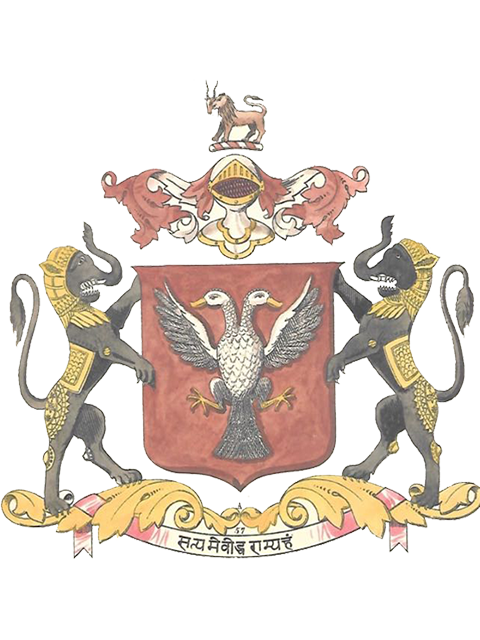
The Royal Coat Of Arms
The Coat of arms of the Royal State of Mysore, was designed by Robert Taylor, Master of Arts, a graduate from Cambridge University and an employee of the Bengal Civil Service. In the centre of the royal coat of arms is the mythical Gandabherunda. The bird symbolizes strength, and is often shown to be aggressive. It has been said that Achyutaraya, one of the later kings of the fabled Vijayanagara empire, minted coins bearing the Gandabherunda, holding an elephant in each of it’s arms and beaks. The motif is thought to have been passed on to Mysore, along with the rest of the traditions and legacy of the empire.
The two heads facing opposite directions are supposed to stand for Justice and Vigilance: when one head sleeps the other keeps awake, thereby fulfilling their duty of eternal protection.
It is held on either sides by the elephant-headed lion Sharabha that again stands for unprecedented strength and valor.
In the pinnacle of the crest stands a majestic lion, holding the severed head of a ‘Mahisha’-symbolic of the victory of the state Goddess Chamundeshwari over the evil Mahishasura.
The lower portion bears the ‘Dhyeyavakya'(oath) of the Maharajas सत्यमेव-उद्धाराम्यहम् (I shall only uphold the truth).
The individual constituents are held together by creepers and vines.
The royal flag is red and brown, and an interesting anecdote about the inclusion of red goes thus- Once, while on an expedition, a ruler of Mysore was gifted a piece of red cloth by a ‘Jangama’ (ascetic) who happened to pass by. Their consequent win was attributed by the said Maharaja to the holy red cloth, and since then, the auspicious red came to be a part of the royal flag too.

